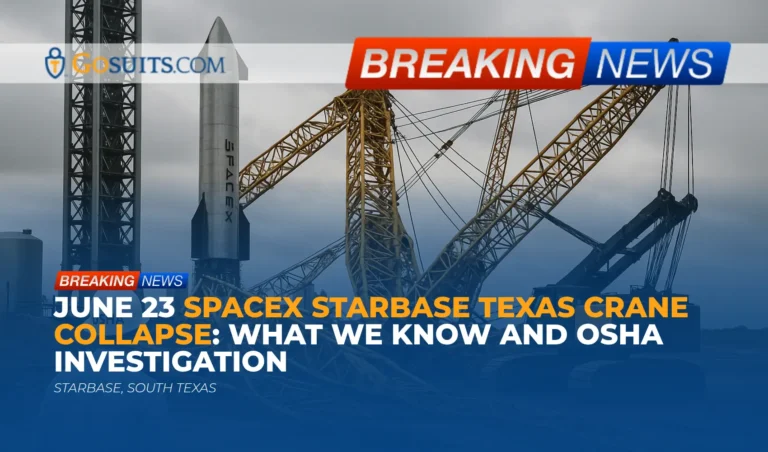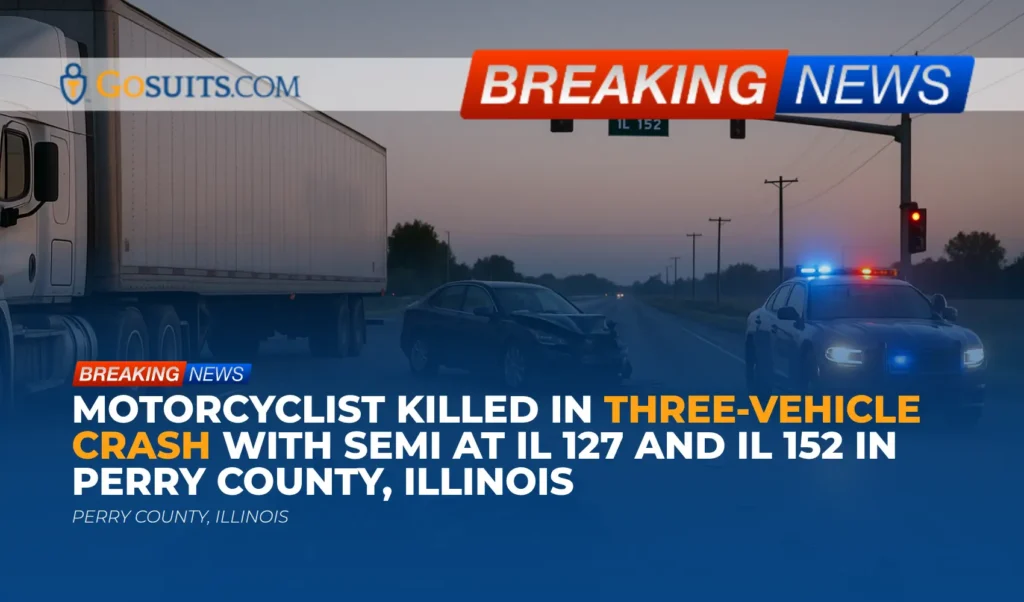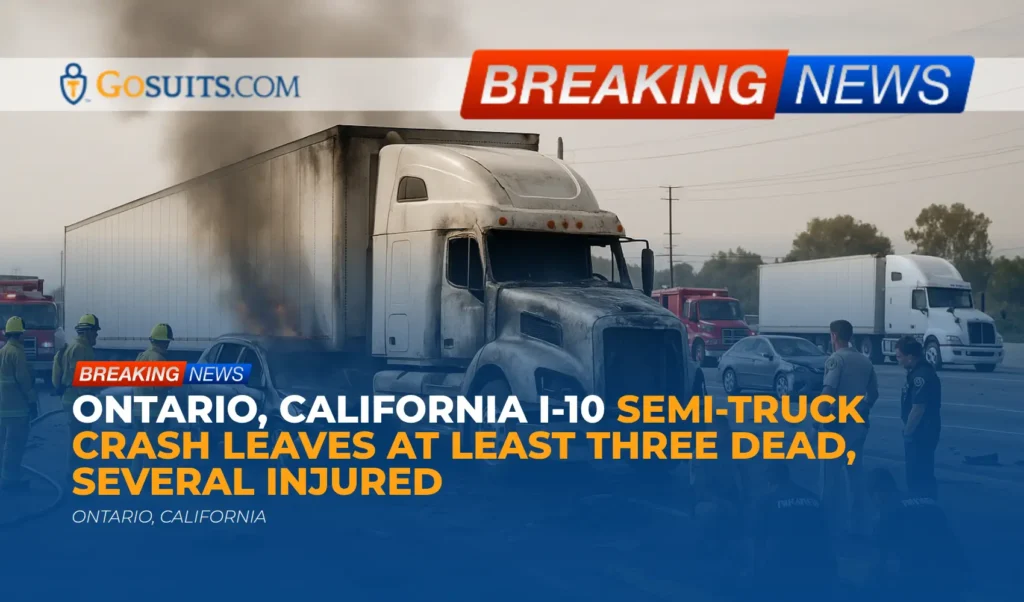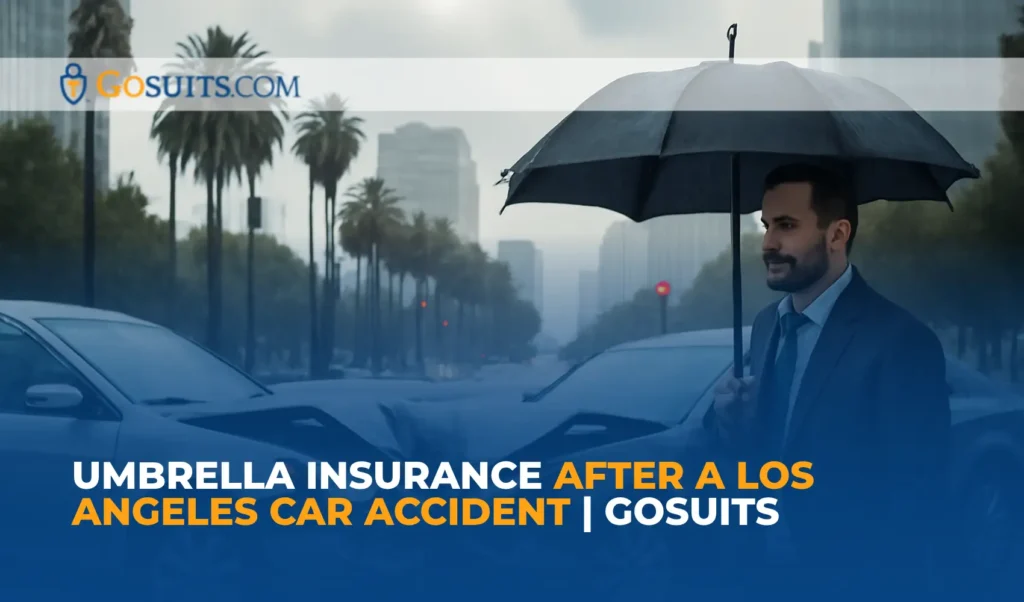- What we know about the Starbase crane collapse on June 23
- Where and when it happened, and who may be affected
- Why crane collapses matter: safety and legal context
- OSHA investigations after industrial incidents
- Potential civil liability pathways in Texas after a crane or industrial incident
- Key steps to preserve your rights after a serious industrial incident
- How to obtain official records and information
- Insurance issues unique to large industrial sites
- Timeline considerations and deadlines in Texas
- Community safety and transparency in a company-led city
- Resources for grief, trauma, and worker support
- Commentary from Gosuits Starbase, Texas Personal Injury Attorney
- Action steps: Why acting promptly matters
What we know about the Starbase crane collapse on June 23
A crane collapse occurred on June 23 at SpaceX’s South Texas launch complex, within the newly incorporated city of Starbase. According to observers, the crane was operating during debris clearance work after a recent rocket explosion at the site. Video footage was reportedly captured by onlookers, but the extent of injuries has not been confirmed publicly. As of this writing, SpaceX has not issued a statement about the incident. This aligns with prior patterns where public communications tend to prioritize spaceflight events over onsite operational mishaps.
Starbase, incorporated in May, is closely tied to SpaceX for governance and funding, including a reported municipal loan from the company to sustain operations. The collapse has prompted an investigation by the Occupational Safety and Health Administration, commonly known as OSHA. OSHA’s findings can influence workplace safety requirements and guide corrective measures.
Given the uncertainty around injuries or potential damage, families and workers may have questions about how investigations proceed, what records exist, and what rights may be available if harm occurred. The sections below explain how federal and Texas laws approach this type of industrial incident.
Where and when it happened, and who may be affected
The event took place June 23 at the Starbase launch complex in South Texas. Starbase is a newly incorporated city in Cameron County. The crane was reportedly engaged in post-explosion debris handling when the collapse occurred.
People potentially affected include on-site employees, contractors and subcontractors, crane operators and riggers, safety personnel, and any authorized visitors or vendors present during the operation. Nearby community members may also have concerns about site safety and emergency response, although current public reports do not indicate injuries beyond the site itself.
Why crane collapses matter: safety and legal context
Cranes are essential to heavy industrial work, but they involve inherent risk, particularly during high-load lifts, debris removal, or in changing wind conditions common in coastal South Texas. Federal workplace safety rules impose specific requirements for crane operations, including operator qualification, signal person duties, equipment inspection, and safe setup. OSHA’s crane standard, known as 29 CFR 1926 Subpart CC, addresses these core topics for construction activities. You can review OSHA’s crane and derrick safety materials at osha.gov/cranes-derricks and the full Subpart CC regulations at osha.gov/laws-regs/regulations/standardnumber/1926/1926SubpartCC.
National surveillance data show that crane incidents remain a serious cause of workplace fatalities and significant injuries. The U.S. Bureau of Labor Statistics’ Census of Fatal Occupational Injuries, a longstanding federal dataset, reports crane-related deaths each year across the United States. For context on occupational injury trends, see BLS’s resources at bls.gov/iif/.
In addition to regulatory requirements, safety guidance from federal health agencies emphasizes planning, inspection, and hazard control to prevent tip-overs, collapses, and struck-by incidents. NIOSH, part of the Centers for Disease Control and Prevention, has published prevention materials for crane operations, including risk factors related to ground conditions, load charts, outrigger use, and weather. See NIOSH’s crane safety publication portal at cdc.gov/niosh/docs/95-108/.
OSHA investigations after industrial incidents
OSHA is the federal agency that investigates workplace incidents at most private employers in Texas. Texas is under federal OSHA enforcement rather than a state OSHA plan, which means OSHA directly enforces federal safety standards for covered employers in Texas. See OSHA’s overview of state plan coverage at osha.gov/stateplans.
Employers are required to report work-related fatalities to OSHA within 8 hours and certain severe injuries within 24 hours, including in-patient hospitalizations, amputations, and loss of an eye. These reporting rules are in OSHA’s regulation at 29 CFR 1904.39. OSHA explains the reporting requirements at osha.gov/report and the specific regulation text at osha.gov/laws-regs/regulations/standardnumber/1904/1904.39.
When OSHA opens an investigation, compliance officers may visit the site, interview witnesses, review documents, and assess whether safety standards and the general duty to provide a workplace free of recognized hazards were met. The process can lead to citations or required abatement measures. Individuals can also submit safety complaints to OSHA, including confidentially, at osha.gov/workers/file-complaint. Federal law protects workers from retaliation for reporting hazards or cooperating with OSHA. Whistleblower protections are explained at whistleblowers.gov.
Once an OSHA case is closed, many records can be requested through the Freedom of Information Act process. OSHA’s FOIA page provides instructions at osha.gov/foia.
Potential civil liability pathways in Texas after a crane or industrial incident
Different legal avenues may apply depending on the injured person’s role, the employer’s insurance choices, and the conduct of multiple companies on site. The points below describe common pathways without drawing conclusions about any party’s responsibility in this specific incident.
- Workers’ compensation for employees of subscribing employers. In Texas, private employers are not required to carry workers’ compensation insurance, but many do. When an employer subscribes, workers’ compensation typically provides medical and wage benefits after a job-related injury, and it can limit an employee’s ability to bring a negligence lawsuit against that subscribing employer. See the Texas Department of Insurance information about coverage and employee benefits at tdi.texas.gov/wc/employee/index.html.
- Non-subscriber employers. If an employer does not carry workers’ compensation, the worker may be able to pursue a civil negligence claim against that employer in addition to seeking other remedies. Texas explains that workers’ compensation coverage is optional for most private employers at tdi.texas.gov/wc/employer/coverage.html.
- Third-party claims. Large worksites often include multiple companies. If a third party’s negligence contributed to an injury, a claim may be possible against that company or a product manufacturer, separate from workers’ compensation. Examples can include crane owners, maintenance contractors, rigging vendors, or site operators other than the injured person’s employer.
- Wrongful death and survival actions in Texas. If a death occurs, certain family members may bring a wrongful death claim under Chapter 71 of the Texas Civil Practice and Remedies Code. A survival action can also be brought on behalf of the estate to recover damages the deceased could have pursued if they had survived. See Texas CPRC Chapter 71 at statutes.capitol.texas.gov/Docs/CP/htm/CP.71.htm.
- Premises and operational liability. Site owners and operators can have duties to keep premises reasonably safe and to coordinate work in a way that does not create unreasonable hazards for others. The specific duties depend on contracts, control over the work, and applicable standards like the OSHA crane rules cited above.
- Product or equipment defects. If a crane or component failed due to a manufacturing or design defect, product liability may be implicated. Determining this typically requires prompt evidence preservation and expert evaluation of the equipment.
Key steps to preserve your rights after a serious industrial incident
Every case turns on its facts, but there are practical steps that commonly help protect health, safety, and legal options after a crane collapse or similar event.
- Prioritize medical evaluation. Seek medical care immediately, even if symptoms seem minor. Certain injuries from blunt force or stress can worsen over time. Obtain copies of all records and follow-up instructions.
- Report the incident promptly. In Texas, injured workers generally must notify their employer within 30 days of the injury. The state’s workers’ compensation division explains employee reporting duties at tdi.texas.gov/wc/employee/reportinjury.html.
- Preserve evidence. Save photos, videos, texts, job assignments, timesheets, and names of witnesses. If possible, note weather conditions, ground conditions, equipment identifiers, and load information. Avoid altering or discarding gear or PPE that may be relevant.
- Be careful with company or insurer statements. Insurance adjusters sometimes request recorded statements quickly. What is said can be used later to challenge claims. Consider consulting a lawyer before speaking to any insurance representative, and obtain a free consultation to understand your rights and obligations.
- Understand claim filing timelines. If workers’ compensation applies, Texas generally requires filing a claim within one year of the injury. The DWC-041 form and related instructions are available through the Texas Department of Insurance. See the employee resources page at tdi.texas.gov/wc/employee/index.html.
- Document income loss. Keep pay stubs, tax forms, and any proof of missed shifts or reduced duty. These records support wage loss evaluations whether through workers’ compensation or third-party claims.
- Respect investigation boundaries. Do not enter restricted areas or attempt to collect physical evidence from an active investigation zone. OSHA and site safety staff may control access for safety and evidentiary reasons.

How to obtain official records and information
After a high-profile industrial incident, families and workers often need official records to understand what happened and to handle benefits, employment, or potential claims. The resources below point to government sources and explain what to ask for.
- OSHA incident records. After OSHA closes an investigation, many materials can be requested via FOIA. Ask for the case file by employer name, incident date, and location. Instructions are at osha.gov/foia.
- OSHA severe injury or fatality reporting confirmation. If applicable, an employer’s initial report to OSHA can sometimes be requested through FOIA as part of the case file. OSHA’s reporting rule is at osha.gov/laws-regs/regulations/standardnumber/1904/1904.39 and general reporting guidance is at osha.gov/report.
- Law enforcement incident records. For on-site industrial accidents, local law enforcement may generate an incident report if they respond. In Texas, public records are accessible under the Public Information Act, with some exceptions for active investigations and sensitive information. Guidance for making an open records request is provided by the Texas Attorney General at texasattorneygeneral.gov/open-government.
- Autopsy or inquest records. In Texas, deaths may be investigated by a medical examiner or justice of the peace under Chapter 49 of the Code of Criminal Procedure. Availability of autopsy reports can depend on the status of any investigation and confidentiality rules. See Chapter 49 at statutes.capitol.texas.gov/Docs/CR/htm/CR.49.htm.
- Death certificates. If a fatality occurred, certified death records are available through the Texas Department of State Health Services Vital Statistics unit. Instructions are at dshs.texas.gov/vital-statistics/death-records.
- Emergency communications. In many jurisdictions, 911 call logs, CAD reports, and radio traffic may be requested through the Public Information Act. Some content can be redacted for privacy or investigative reasons. See the Texas Attorney General’s open government resources at texasattorneygeneral.gov/open-government.
- Work status and benefits documentation. Injured employees can request copies of their personnel file, safety training records, and any incident forms submitted to the employer. If workers’ compensation applies, retain copies of all forms, including any DWC filings. The employee resource hub is at tdi.texas.gov/wc/employee/index.html.
When requesting records, provide clear identifiers like incident date, location, employer name, and, if applicable, the responding agency’s case number. Keep copies of all requests and replies.
Insurance issues unique to large industrial sites
Major industrial operations often involve multiple layers of coverage and risk management. Understanding these layers can help ensure claims are directed to the correct insurers and that no coverage options are overlooked.
- Workers’ compensation vs. occupational benefit plans. Some Texas employers are non-subscribers and instead use occupational benefit plans administered by third parties. These plans are not the same as state-regulated workers’ compensation and may require specific notice and appeal processes. Verify the employer’s status before making any recorded statements.
- Owner-controlled insurance programs. At large worksites, an owner-controlled insurance program can cover multiple contractors. This can simplify some claims but complicate responsibility and notice requirements. Read all site onboarding packets and keep copies.
- Multiple at-fault entities. Crane operations can engage crane owners, rental firms, rigging companies, maintenance providers, general contractors, and site owners. Liability may be shared. Early investigation helps identify which insurers to put on notice.
- Recorded statements and releases. Insurers sometimes move quickly to obtain statements or propose early settlements before the full scope of injuries is known. Consider contacting an attorney first. What is said to an insurer can be used later to challenge a claim.
- Property damage and business interruption issues. If a vehicle or personal property was affected, separate property claims may be available. Document damage thoroughly and preserve receipts.
Timeline considerations and deadlines in Texas
Texas law sets important deadlines for injury and death claims. Missing a deadline can limit or eliminate legal options.
- Report to employer within 30 days. For workers’ compensation cases, employees should report injuries to their employer within 30 days. See Texas DWC guidance at tdi.texas.gov/wc/employee/reportinjury.html.
- File a workers’ compensation claim within one year. Injured workers generally must file a claim with the Division of Workers’ Compensation within one year of the injury. See employee resources at tdi.texas.gov/wc/employee/index.html.
- Two-year limitations period for many civil claims. Texas sets a two-year statute of limitations for wrongful death and many personal injury claims, measured from the date of the injury or death, unless an exception applies. See Texas Civil Practice and Remedies Code section 16.003 at statutes.capitol.texas.gov/Docs/CP/htm/CP.16.htm#16.003, and Chapter 71 for wrongful death at statutes.capitol.texas.gov/Docs/CP/htm/CP.71.htm.
- Preservation letters. If a civil claim is anticipated, consider sending spoliation or preservation letters to potentially responsible parties as early as possible to request preservation of documents, equipment, telemetry, and video.
Community safety and transparency in a company-led city
Starbase’s unique structure, with municipal leadership connected to the primary corporate operator, raises reasonable community questions about transparency and independent oversight. In Texas, the Public Information Act and the Open Meetings Act are intended to promote accountability in government activities, including newly incorporated cities. The Texas Attorney General’s Open Government page provides guidance on public access rights and how to request information at texasattorneygeneral.gov/open-government.
While operational safety is ultimately enforced by federal OSHA for private employers, local government processes can still matter for emergency planning, public safety coordination, and access control measures such as road or gate restrictions. Community members can monitor posted meeting notices, request agendas and minutes under state law, and ask for nonconfidential records related to safety planning.
Resources for grief, trauma, and worker support
Industrial incidents can create lasting stress for workers and families, even when physical injuries are not immediately apparent. Federal resources offer confidential support.
- Behavioral health support. The Disaster Distress Helpline offers crisis counseling 24 hours a day through the Substance Abuse and Mental Health Services Administration. Information is available at samhsa.gov/find-help/disaster-distress-helpline.
- Workplace safety education. OSHA’s worker page explains how to identify hazards, file a complaint, and understand rights under federal law at osha.gov/workers.
- NIOSH safety research. NIOSH provides educational materials for preventing falls, struck-by incidents, and equipment failures, which can help workers and supervisors adopt safer practices. See cdc.gov/niosh/.

Commentary from Gosuits Starbase, Texas Personal Injury Attorney
Our thoughts are with those who were present during the crane collapse at the Starbase launch complex, and with anyone anxiously awaiting updates. This article is intended for general information and education. As details continue to develop, compassion and clarity are essential for workers, families, and the surrounding community.
From a personal injury perspective, crane collapses often signal a breakdown in one or more safety layers, whether related to planning, site coordination, inspection, or equipment integrity. OSHA’s involvement is an important step toward understanding whether required safeguards were in place. When multiple companies share a site, clear lines of responsibility can blur, which is why preserving evidence early can be so important.
In our experience, large corporations and their insurers move quickly after an incident to gather statements, shape the narrative, and limit exposure. People who have just experienced a traumatic event may not realize how fast their words can be used to minimize the significance of injuries or to assign blame. Insurance carriers sometimes request recorded statements before the person has even seen a doctor or obtained key documents. It is wise to speak with an attorney first, because once a statement is made, it can be difficult to correct misunderstandings later.
A free consultation provides a practical way to understand options without pressure. It can help clarify whether workers’ compensation applies, whether the employer is a non-subscriber, and whether there may be third-party responsibility related to crane ownership, rigging, or site operations. Even if no claim is filed, getting informed early can help avoid costly mistakes.
Action steps: Why acting promptly matters
What to do next depends on each situation, but certain actions commonly improve outcomes and reduce stress.
- Get medical care and document everything. Prompt evaluation protects health and creates a clear record of injuries. Keep all discharge papers, imaging results, and referrals.
- Secure your own evidence. Save photos, notes about equipment and conditions, and the names and contact information of witnesses. Your personal documentation can be crucial if official reports are delayed.
- Confirm employer coverage status. Identify whether the employer is a workers’ compensation subscriber or a non-subscriber. This shapes the path of benefits and claims.
- Request key records early. OSHA files, incident reports, and, if applicable, inquest documents can take time to obtain. Start the process now to avoid delays when decisions must be made.
- Be cautious with insurers. Do not give recorded statements or sign releases before understanding the implications. Early statements can affect medical care approvals and settlement positions later on.
- Track deadlines. Put calendar reminders for the 30-day employer notice and the one-year workers’ compensation claim filing window, as well as the two-year civil limitations period.
- Seek a free consultation before contacting insurers. Talking with an attorney first can prevent common pitfalls. What someone says to an insurance company can be used against them later.
Acting promptly provides more time to gather facts, understand coverage, and protect rights. Waiting can lead to missing documents, fading memories, and tighter legal deadlines. Even if it turns out that no injuries occurred, taking these steps brings peace of mind and a clearer picture of what happened.






